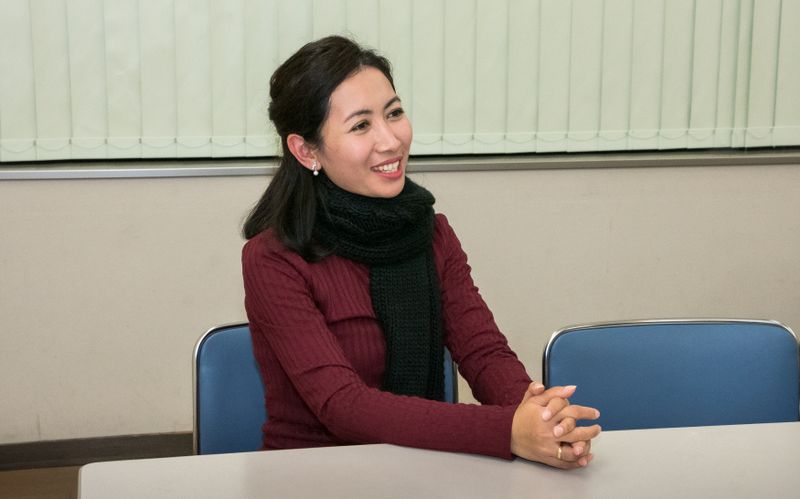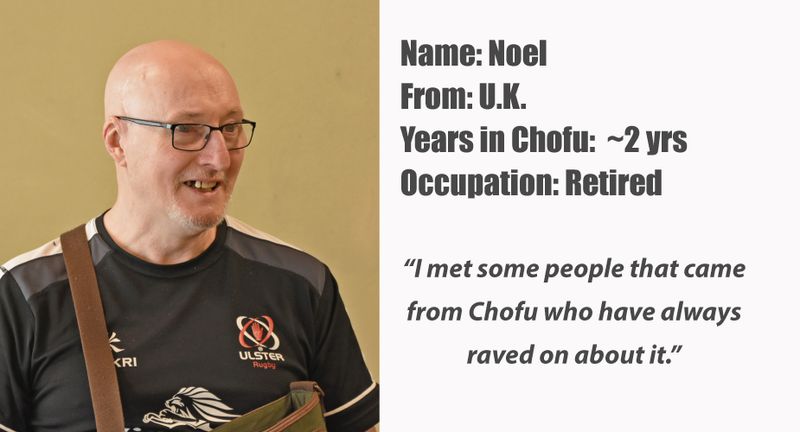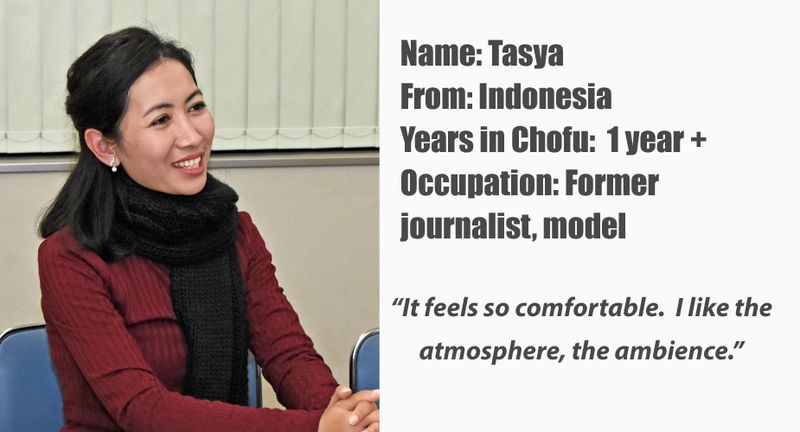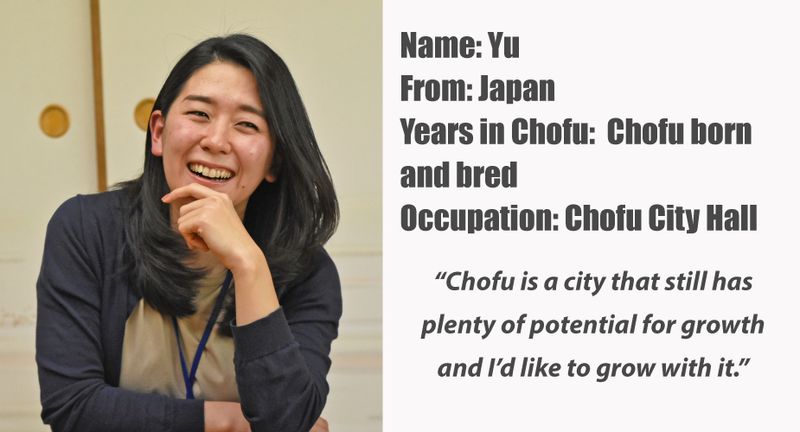Mar 15, 2021
Living in Chofu, Tokyo: A word or two on life west of Shinjuku

Residents describe their experience of living in Chofu, the city west of Tokyo’s Shinjuku district.
Since beginning our collaboration with the city of Chofu team City-Cost has been a regular visitor to the city located just west of Shinjuku, typically charged with the task of putting the experience of our visits into words.
We were in Chofu among the fans to try and capture, using these words, the heady atmosphere during opening weekend of the Rugby World Cup 2019 when the city and its people embraced the eyes of the world and in return put on a display of “omotenashi” that finally and emphatically gave us meaning to the illusive, yet over marketed, term for “Japanese hospitality.”
We’ve read the words of manga legend and honorary Chofu resident Shigeru Mizuki, had conversations with the people maintaining the “Mizuki manga” legacy and attempted to describe our experience of pounding the streets at night in search of Mizuki’s yokai.
At Jindaiji Temple, a Chofu icon, we sat cloistered in silent meditation (and no small degree of discomfort) in order to put into words the experience of the otherworldly and fiery "Gomadaki" ritual. Much more comfortable was the experience of dining our way through Chofu’s eateries -- from coffee and sweets in Sengawa to beef tongue and beer downtown -- though putting the myriad of flavors down on paper, so to speak, was a stiff enough challenge.
Perhaps it may come as no small relief to all then, that on this particular visit to the city to learn more about the experience of living in Chofu we can all sit back and listen to the words of others, in this case residents Chofu and their words of insight into life in this part of Tokyo.
But first some official words on the city -- population 237,815 (as of Jan.8, 2021), 4,550 of which are foreign nationals, residing in an area of just over 21 square kilometers, flanked in the south and west by the Tama River with downtown Shinjuku around 10km to the east (around 15 minutes by express train).
Chofu, the birthplace of master swordsman Isami Kondo -- official leader of Japan’s band of “last samurai” the Shinsengumi -- and home to GeGeGe no Kitaro creator Shigeru Mizuki. Chofu is also home to J1 League soccer teams Tokyo Verdy and F.C. Tokyo who play their home matches in the city’s Ajinomoto Stadium (also venue for matches during the Rugby World Cup 2019 as well as one of the best flea markets in Tokyo).
Chofu, also to be found under, “Movie Town, Chofu,” and “Mizuki Manga’s birthplace, Chofu.”

After dividing their time between Tokyo, London and bouts of globe trotting that took in cities such as Singapore and Hong Kong, Noel and his wife began living in Chofu two years ago after making the move from Tokyo’s Waseda district.
“I met some people that came from Chofu who have always raved on about it. This is Japanese people by the way,” Noel said. So, when the opportunity came, my wife found the place to live. She said, “It’s in Chofu.” I said, “OK!”
From their Chofu base Noel enjoys the retired life, one which leaves plenty of time for studying Japanese with the city’s international friendship association.
Your impression of living in Chofu
I like Chofu. I’d known about it for a long time because I used to live in Waseda. I’ve always traveled through (Chofu).
I met some people that came from Chofu who have always raved on about it. This is Japanese people by the way, not foreigners. So, when the opportunity came, my wife found the accommodation, she said “Kokuryo.” I said, “Where?” She says, “It’s in Chofu.” I said, “OK. Lets go check it out.”
Its two minutes walk from the underground station, which is brilliant. And one minute from McDonald’s which is even better. For me, anyway!
We’re so close to the stores as well. Of course, the convenience stores are everywhere, aren’t they? That’s the beauty about Japan. Convenience stores!
And the other good thing about living in Chofu is transportation. It’s easy to get to Shinjuku from here. It’s easy to get anywhere, actually.
How is it as a place to meet people, find community?
Well, I meet lots of locals. Sometimes we meet in the bar, or here (at the community center). You’d be surprised how many people speak English. I try to practice my Japanese but very quickly the conversation switches to English, and I find myself speaking English to them.
<So friendly people here then?>
Yes, and I would say nosey. [Laughs]
They want to know, “Where do you come from?” “How old are you?” “What do you do here?”
What about places for leisure? Places to hang out in Chofu?
The Tamagawa River walk is really nice. Foreigners call it, “Tamazon.” That’s the nickname -- because it’s such a wide river. But it’s a really nice area to walk, especially in the summer when you get this breeze, a bit of cool air. It’s really nice. There are cherry blossoms and a lot of wildlife as well.
It’s nice to cycle down there. There’s a lot of activity. It’s a green space so there is a lot of people down there.
And then of course there's Jindaiji, which everyone raves on about. To be honest, I like it there because of the soba noodles. I usually go in the spring (when there are) less people. It’s a nice place.
Dining out in Chofu. What bars and restaurants do you recommend in Chofu?
I can’t tell you that! Those are my secret places. Where I go and hide! [Laughs]
Seriously though, in Kokuryo there’s a really good sushi restaurant … very close to the station. Freshly prepared. Absolutely delicious! And they do these raw oysters. They’re as big as your hand. They are so good and fresh. So, I can recommend raw oysters and sake.
They also have a ramen noodle restaurant in Kokuryo. Japanese people tell me it’s the number one ramen noodle restaurant in the area. I’ve got to believe them because lots of taxi drivers go there!
And then, in Chofu itself, not too far from the station there’s a great unagi restaurant. It’s really good. You can get a bento (lunch) box -- a large size is probably the size of your laptop screen. I go for the smaller size because it’s too much for me … but it’s absolutely amazing!
But I shouldn’t divulge my secrets otherwise next time I go everyone will be there! [Laughs]
Any events to look out for in Chofu?
Tamagawa River fireworks. Really good. The first time we went there we got a boat which goes down the river and you can drink beer and just lay back and watch the fireworks. It’s good.
Now I just go out on my balcony and look up and I can see the fireworks. Which is good!
What are some good trips outside of the city?
I like Hachioji and Minami-Osawa. Minami-Osawa has an outlet mall. From Kokuryo it’s about 30 minutes (to Minami-Osawa). Straightforward on the train. It’s easy!
(Hachioji) is a good place for walking. They have Hachioji Castle there, you know? It’s in ruins but there’s a really good story behind it. I went there recently and they’ve started to do the reconstruction of it.
There’s an island (Oshima) we used to go to from Chofu, because Chofu has a small airport. So we used to go to the airport, get on the aircraft and fly to the island. It’s part of Tokyo. I enjoyed it.
THE Chofu view
From the Sky Restaurant Prestige, on the top floor (twelfth floor of Chofu City Cultural Hall Tazukuri). You have a really good view. You can see the amusement park, there’s a big (ferris) wheel there. You can see the Tama River as well. I think night time is good because it’s all lit up.
What would you miss about living in Chofu?
I would miss the weather. The sunshine. Every day the sun shines here!

Maybe it says something about Chofu that one might be prepared to swap life on the island of Bali, Indonesia for life just west of Shinjuku. Anyway, it’s a case of “so far, so good,” for Tasya who at the time of writing was just over a year into life in the city, after having had some Japan experience through holidays on these shores as well as work coordinating wedding ceremonies for Japanese couples in Bali.
Your impression of living in Chofu?
It feels so comfortable. I like the atmosphere, the ambience.
(My husband and I), we chose Chofu because the city is close to many places … like central places such as Shinjuku. It’s very convenient. It’s so helpful. When I need some groceries for daily needs, just five minutes from my home there are supermarkets like a Seiyu, OK, so it’s really easy for me to find. I can go everyday to buy fresh vegetables or something.
How is it as a place to meet people, find community?
I have a few friends here so it’s easy for me to hang out together (with them), catch up together, visit my friends’ homes, or have my friends come to my home.
I have found a community in the Chofu International Friendship Association (CIFA).
I joined an event held by CIFA so I made friends from other countries. It was so nice to meet them. CIFA’s members come from a variety of countries. They are all so nice, too. We went hiking together to Mt. Takao.
What about places for leisure? Places to hang out in Chofu?
Usually I go to karaoke. Actually, I like to go to the cinema but because of the language I have only been twice. But many times I go to karaoke because I love singing … with my husband and friends. English songs, Japanese songs, … there are no Indonesian songs on the list at the karaoke place. [Laughs]
I have been to Jindaiji many times. It’s easy to go to Jindaiji. It’s so beautiful. We can go to Jindaiji every season ... even now in the cold season it’s OK to go to Jidaiji but when the flowers are blooming it’s very beautiful. The gardens are very beautiful.
I would recommend Ajinomoto Stadium (also known as Tokyo Stadium). At the beginning I really didn’t notice this stadium in Chofu, but my friends asked me if I had ever been there.
Also, Nogawa. Nogawa is a river and park area. It’s very beautiful especially in the cherry blossom season. The cherry blossoms are so nice. It’s close, too. We can walk. From here (Chofu Station area) it’s around 20 minutes on foot (to the river). There's a bus also.
Dining out in Chofu. What restaurants do you recommend in Chofu?
In Chofu there are many restaurants that I would recommend. You can find many at PARCO (department store) -- there are restaurants that offer various kinds of food. There are so many.
What are some good trips outside of the city?
Many places, but I also go to Sengawa. There are many cafes and a shopping arcade there.
I often go to Shinjuku, just for window shopping or to get fast food. Just walking around from Shinjuku Station. It’s refreshing for me.
THE Chofu view
Muzukashii (It’s difficult)! [Laughs]
Jindaiji? I mean, it’s legendary. It’s an iconic place. Yeah, Jindaiji!
What would you miss about living in Chofu?
I would miss everything! I would miss the food. I would miss the shopping areas. I would miss my friends. I would miss ... everything!
In Chofu I feel in my comfort zone. So, so far so good!

Chofu born and bred Yu’s affection for her hometown appears as infectious as it is considered and knowledgeable. This knowledge is backed by a career working in the city hall which has seen Yu involved in local tourism (Yu used to work on the organization of the city’s, and one of Tokyo’s, celebrated fireworks events so if you’re after tips on how best to enjoy it … ) and town planning.
Oh, and if you’re looking for great places to dine out in Chofu, Yu has an apparently endless list of spots to recommend!
Your impression of living in Chofu?
It’s a city that is not too rural but still has a good local feel to it, so it’s just right. And each station area has its own personality.
Access to central Tokyo is easy but on the other hand we can also easily go to areas with plenty of nature like Mt. Takao.
It’s also really convenient in terms of daily life. You can find everything here. There are lots of supermarkets, too. I never have trouble (finding things I need for daily life).
(In terms of classes) I think you can try many different things to learn. The city hall has lots of information. There are many people here doing different things, for example shodo (a kind of Japanese calligraphy) or flower arranging so you can learn these kinds of cultural practices. Or if you want to play sports, there are lots of organizations, so I think you can pretty much do anything.
What about places for leisure? Places to hang out in Chofu?
I like to spend time in the cafes around Chofu station. Or the Tama River area is a good place, too. I spend a lot of time there, walking or running. And places like the Nogawa River where I go walking.
The scenery around the Nogawa River makes me think, “Wow! There’s such a beautiful place here in Chofu.” The cherry trees bloom in spring and as summer comes it becomes green. Looking over the river from the bridges I feel like it’s really nice that this city has this kind of scenery.
Dining out in Chofu. What restaurants do you recommend in Chofu?
So many!
First of all, the place where I would want to bring my friends is Jindaiji Temple and the soba restaurants there. The location is good and the soba (noodles) are tasty so I would definitely bring my friends there.
Also, there’s my friend's place. Do you know Shibasaki station? It’s only a small station but there’s a bar called “Teru.” It’s smart and the food is good. They can make anything but they serve delicious sashimi and they’ll grill you a steak. Meat, fish, vegetables … they can serve anything. Teru, it seems, used to work on a U.S. military base so he knows about overseas cuisine so I think it would be a good spot for foreigners, too.
The ramen shop Shibasaki-tei is famous. It’s near Tsutsujigaoka station. It’s really popular. The ramen isn’t so oily. It’s kind of trendy. Ramen places might have a greasy image but there the soup is kind of clear and refreshing.
Now that I’ve started, I can’t stop!
The Rugby World Cup (2019) was a big experience for Chofu, I think. At that time many foreigners came and I guess they ate out (in the city). I think the restaurants around Chofu station would have gained a lot of experience from that.
Any events to look out for in Chofu?
Hanabi! [Laughs]
Hanabi (fireworks) is part of Japanese culture so I would recommend it, for Japanese people and for foreigners. Compared to, say, the Sumida River event, the size of the fireworks (used for the Chofu event) is bigger and you can see them from pretty close-up so that sense of their power is appealing. Also, access on foot from train stations is comparatively easier. You can walk to the event site from Chofu and Fuda stations. As it’s not such a rural area you can have something to eat before you head home.
You can buy reserved seats for the event - to be in the best place to see all of the fireworks clearly, to be able to hear the music and the announcements properly. If you’re coming, you should definitely buy a seat.
The scale of the event is not as huge as other fireworks events in Japan but it has been held for more than 35 years now. I think it’s one of the major cultures of Chofu.
Jindaiji Temple is a really fun place to go when there are events on there. The one I recommend is the Soba Matsuri.
Jindaiji is famous for soba. The Soba Matsuri is an event held in cooperation with the local soba shops. It’s like a stamp rally. If you go around all of the soba shops, you can get the soba choko cup (in which noodles are dipped into a kind of stock). It’s held in November, soba harvest season, so it's an event where you can eat the first soba of the season.
I help out during soba events at Jindaiji. I learned about soba with a soba making club in the city hall. It’s called the Jindaiji Soba Uchi Club. I think it’s probably unique to Chofu!
One of the big annual events in Chofu is the Cinema Festival. Living here you don’t necessarily see film culture right in front of you but there are big studios here and in its heyday a lot of actors came to Chofu and there were many companies, like lighting companies, related to the movie industry here. It was a city with a strong film culture.
It’s an event that focuses on movie makers rather than the movie stars. It puts the spotlight on the people behind current and popular movies. There aren’t many events that showcase the work of, say, people doing the audio and lighting so thinking about it from this perspective it’s an event unique to “movie town, Chofu.”
They also have exhibitions of props used in movies which are otherwise difficult to see. You can also see how movie making is done - a set is made at the event site, actors come and a 15-minute screenplay is prepared and you can actually experience how movies are made. And it’s not just about observing. You can actually get involved in the production process.
What are some good trips outside of the city?
I often go by bicycle to Futako-Tamagawa, “Nikotama.” Do you know it? You just follow the Tama River all the way there, about 40 minutes.
I also go by bicycle to Kichijoji. It takes about 30 minutes.
Nikotama is quite a trendy town and there are things there that you can’t find in Chofu. I go there to shop for more luxury items and also maybe to have some tea or food. Maybe watch a movie.
Kichijoji has got this charming mix to it that makes it a fun place to just walk around. It has an interesting shoutengai (retro shopping arcade).
THE Chofu view
The Tokyu store sign board! [Laughs]
There’s a supermarket called, “Tokyu.” Above that is an apartment building and on top of that is a big “Tokyu” sign board. That’s the Chofu view for me! [Laughs]
It’s difficult to explain to people not from the city.
What would you miss about living in Chofu?
I can’t answer this question! I’d like to spend my life here. My family is here and probably I will continue to work at the city hall. I think Chofu is a city that still has plenty of potential for growth and I’d like to grow with it. That’s how I feel.
This article was supported by Chofu City.



0 Comments